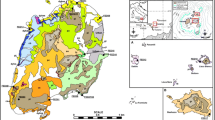Abstract
Basaltic lavas from the AMAR Valley and the Narrowgate region of the FAMOUS Valley on the Mid-Atlantic Ridge (36° to 37° N) range in texture from aphyric to highly plagioclase phyric (>25% large plagioclase phenocrysts). Based on 87Sr/86Sr and 143Nd/144Nd ratios, most of these lavas can be subdivided into two distinct, isotopically homogeneous, groups: Group I has lower 87Sr/86Sr (0.70288±1) and higher 143Nd/144Nd (0.51312±1) ratios; Group II has higher 87Sr/86Sr (0.70296±1) and lower 143Nd/144Nd (0.51309±2) ratios. Most Group II lavas are aphyric, whereas Group I lavas are primarily plagioclase phyric. Lavas from both groups show a wide range in incompatible element abundance ratios (e.g., Zr/Nb =6–29; (La/Sm)n=0.6–1.7). Aphyric lavas have relatively constant Sc (40±1.5 ppm) abundances and CaO/Al2O3 ratios (0.80±0.02). Group I lavas are confined primarily to the AMAR rift valley floor whereas Group II lavas are found along the east and west marginal highs. We interpret the isotopic differences between the two groups as reflecting a temporal change in the upwelling mantle beneath this region of the Mid-Atlantic Ridge which is south of the Azore Islands. For each group, a petrogenetic model consistent with the geochemical data is multi-stage decompression melting of an initially enriched, homogeneous, mantle source region. If the early derived, incompatible-element enriched, melt increments are not always pooled with subsequent increments, the erupted magma batches may have the major element characteristics of melts derived by 10 to 20% melting, but with incompatible element abundance ratios reflecting the change from an enriched to depleted source during the incremental melting process. In this process an initially homogeneous source can generate primary magmas with the required range in incompatible element abundance ratios shown by each group. The nearly constant CaO/Al2O3 ratios and Sc contents of the aphyric lavas with decreasing Mg ? reflects subsequent polybaric fractionation of clinopyroxene, plagioclase and olivine over the pressure interval 8–6 kbar (24–18 km), followed by rapid transport to the surface and eruption. There is no geochemical evidence for a crustal magma chamber beneath this section of the Mid-Atlantic Ridge.
Similar content being viewed by others
Author information
Authors and Affiliations
Additional information
Received: 16 May 1995/Accepted: 3 January 1996
Rights and permissions
About this article
Cite this article
le Roex, A., Frey, F. & Richardson, S. Petrogenesis of lavas from the AMAR Valley and Narrowgate region of the FAMOUS Valley, 36°–37°N on the Mid-Atlantic Ridge. Contrib Mineral Petrol 124, 167–184 (1996). https://doi.org/10.1007/s004100050183
Issue Date:
DOI: https://doi.org/10.1007/s004100050183




